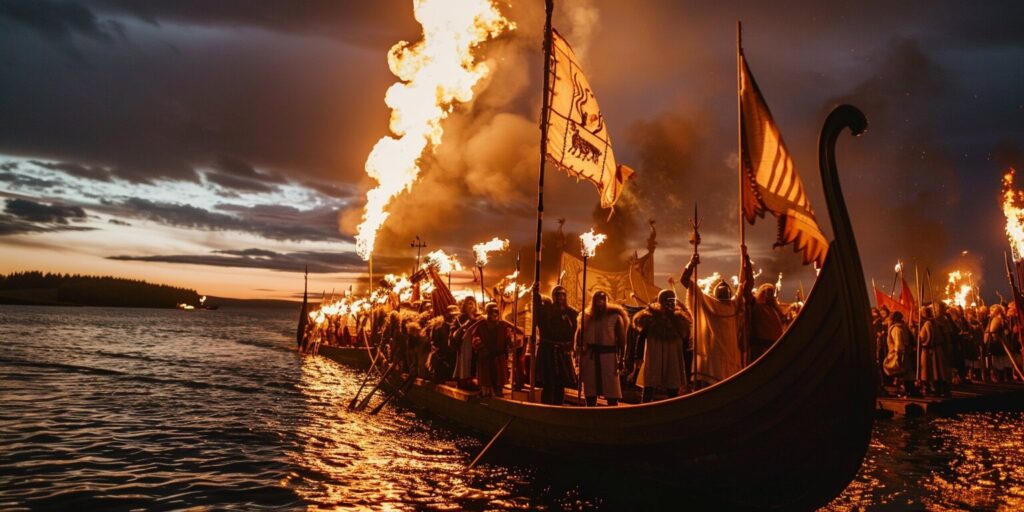Daily Life in the Viking Age, Vikings
Viking Festivals: The Truth Behind Masks and Seasonal Celebrations
Welcome to the enchanting world of Viking seasonal celebrations! Step into the past and discover the ancient traditions, pagan holidays, and Nordic heritage that have shaped these vibrant festivities. From elaborate feasts to mystical masks, we invite you to uncover the hidden truths behind Viking festivals.
For centuries, Viking communities celebrated the changing seasons with exuberance and reverence. These rituals were a time of merriment and an opportunity to connect with their spiritual beliefs and honor their ancestors. With a rich tapestry of customs and traditions, Viking seasonal celebrations offer a fascinating window into the past. Together, let’s celebrate the intricacies of these ancient rituals, honor their enduring legacy, and preserve this cultural treasure for generations to come.
The Origins of Viking Seasonal Celebrations
Viking seasonal celebrations have a rich history that dates back to ancient times, influenced by a blend of ancient rituals and pagan holidays. These festivities hold deep spiritual and cultural significance for the Viking people.
Ancient Rituals and Pagan Holidays
The origins of Viking seasonal celebrations can be traced back to ancient rituals practiced by the Norse people. These rituals were deeply connected to the changing seasons and the Earth’s natural cycles.
The Vikings honored the solstices and equinoxes, which marked important moments in the sun’s journey across the sky. These celestial events were seen as turning points in the year, signifying the transition from one season to another.
Pagan holidays, such as the Feast of Freyja and the Festival of Yule, significantly shaped Viking seasonal celebrations. These holidays were rooted in the worship of Norse gods and goddesses and were held to honor their divine powers and blessings.
Blending with Nordic Traditions
Viking seasonal celebrations were also deeply intertwined with Nordic traditions that were passed down through generations. These traditions encompassed various aspects of Viking life, including religion, agriculture, and community bonds.
Throughout the year, the Viking people celebrated harvest festivals to give thanks for a bountiful season and to secure blessings for the upcoming planting season. These festivities were characterized by feasting, dancing, and the exchange of gifts.
The blending of ancient rituals, pagan holidays, and Nordic traditions created a unique celebration tapestry reflecting the Vikings’ strong connection with nature, their gods, and their cultural identity.
Next, we will explore the specific feasts and celebrations that took place during Viking seasonal festivities, shedding light on the importance of communal feasting and the role of food in these celebrations.
The Viking Feasts and Celebrations
Part of the Vikings’ rich cultural heritage was their tradition of hosting elaborate feasts and celebrations during their seasonal festivities. These gatherings played a vital role in bringing communities together, fostering social bonds, and honoring their pagan beliefs.
During Viking seasonal celebrations, viking feasts and celebrations were grand events where food and drink flowed abundantly. The feasts were a time of indulgence and symbolized prosperity and abundance. The Vikings believed that feasting together would ensure good fortune and blessings for the year ahead.
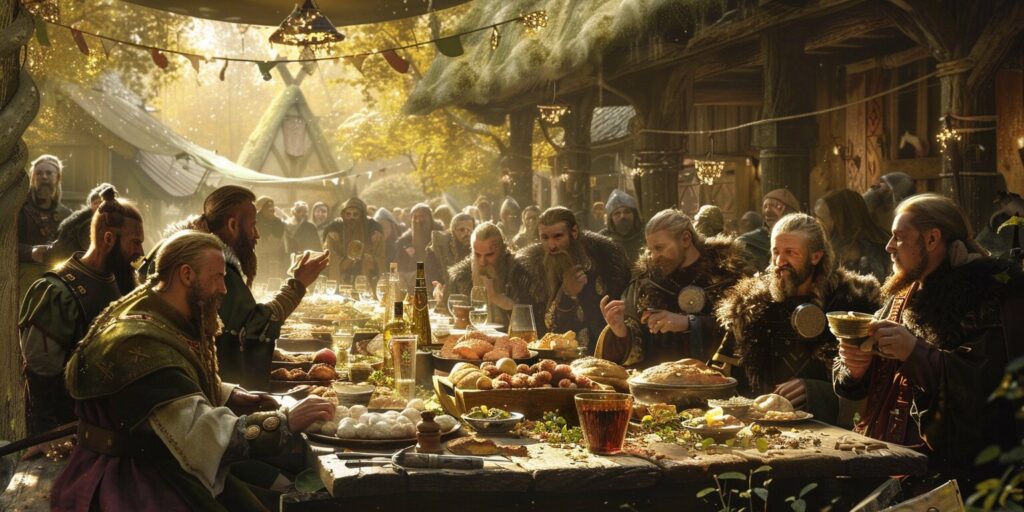
The preparations for these feasts were meticulous, with the finest ingredients sourced and a variety of dishes prepared to satisfy the guests. The Viking feasts were a true culinary experience, from succulent roasted meats to hearty stews. The viking seasonal celebrations were also an opportunity to showcase the community’s culinary skills and celebrate the bounty of the land.
The feasts were not just about the food; they were also accompanied by lively entertainment and festivities. Skalds, or Viking poets, recited epic sagas and poems recounting heroic tales of the gods and warriors. Music, singing, and dancing filled the air, creating a vibrant and joyous atmosphere.
The Viking feasts and celebrations were not limited to specific holidays or occasions. They were an integral part of the seasonal cycles, honoring the changing of the seasons and the natural rhythms of life. Each season had its own unique feast, reflecting the abundance of that time of year and the milestones within the agricultural calendar.
“These communal feasts were held throughout the year, marking important pagan holidays and embracing the Viking’s connection to nature and the divine,” explains Lars Magnussen, a renowned Viking historian. “The feasts were a time of unity, gratitude, and celebration, where the community would come together to honor their traditions and bond over food and merriment.”
The Types of Viking Feasts and Celebrations:
1. Harvest Feast: Held in autumn, this feast celebrated the successful harvest and gave thanks for the abundance of crops. It was a time of reflection and gratitude.
2. Yule Feast: The winter solstice celebration known as Yule was one of the most important feasts in Viking culture. It marked the year’s turning point and the sun’s rebirth.
3. Midsummer Feast: Held during the summer solstice, the Midsummer Feast honored the sun’s power and the land’s fertility. It was a time of joy and revelry.
4. Fishing Feast: Celebrated during the fishing season, this feast honored the bountiful seas and the Viking’s connection to the sea gods.
5. Hunting Feast: After a successful hunting season, this feast celebrated the Vikings’ prowess as skilled hunters and their deep respect for the natural world.
Through these feasts, the Vikings nourished their bodies and spirits, reinforcing their bonds as a community and honoring their ancestral traditions. The viking feasts and celebrations were a testament to their vibrant culture, rich with sumptuous food, lively entertainment, and a deep connection to the spiritual world.
Winter Solstice Celebration: Yule
In Viking culture, the winter solstice was a time of great celebration and significance. Known as Yule, this festive occasion marked the longest night of the year and the return of the sun. It was a time to gather with loved ones, feast, and honor the cycle of the seasons.
The Yule celebration was deeply rooted in the pagan traditions of the Vikings. It was a time to pay homage to the gods and goddesses, particularly Odin, the god of wisdom and war, and Freya, the goddess of love and fertility. These deities were honored through rituals, songs, and offerings.
The Traditions of Yule
During Yule, the Vikings adorned their homes and hearths with evergreen branches and lit candles to symbolize warmth and light during the darkest time of the year. The Yule log, a large oak log, was often burned in the hearth to keep evil spirits at bay and bring good luck for the coming year.
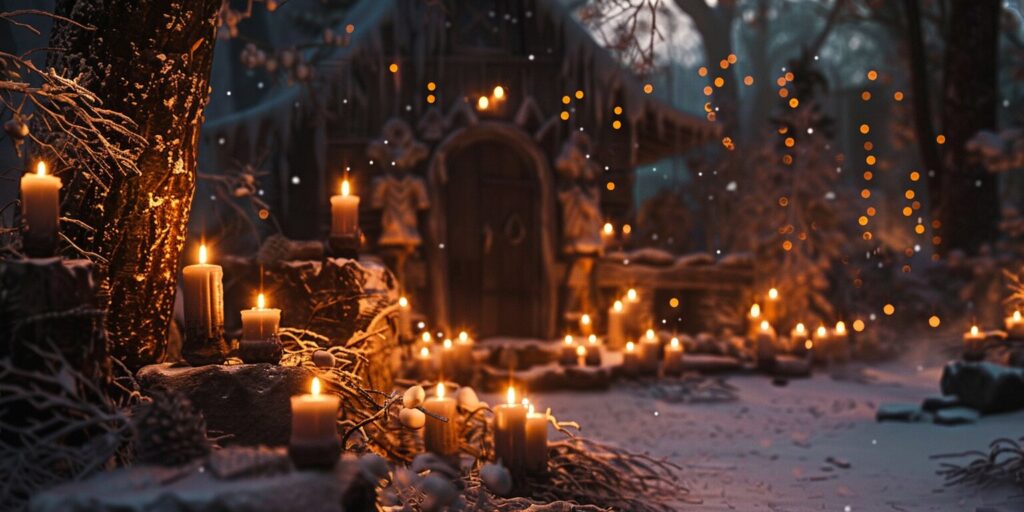
Feasting was an integral part of the Yule celebration. The Vikings would gather with family and friends to indulge in a bountiful feast, enjoying hearty dishes such as roasted meats, fish, and mead, a traditional honey-based alcoholic beverage. The feast was a time of joy and merriment, strengthening community bonds and fostering a sense of unity.
Rituals and Symbolism
Yule was also a time for various rituals and customs. One such ritual was the “Yule boar,” in which a boar’s head decorated with evergreen branches was brought into the hall as a sacred offering. This symbolized both the hunt for sustenance during the winter months and the cycle of life and death.
Another important tradition during Yule was the exchange of gifts. Family and friends would exchange tokens of love and appreciation, symbolizing the renewal of relationships and the continuation of life despite the darkness of winter. This practice laid the foundation for the gift-giving traditions prevalent in modern-day holiday celebrations.
The symbolism of Yule extended beyond the physical realm. It represented the triumph of light over darkness, warmth over cold, and life over death. The celebration was a testament to the resilience of the human spirit and the hope for brighter days to come.
Yule held a special place in the hearts of the Vikings, reminding them of their connection to nature and the cyclical nature of life. It was a time to come together, reflect on the past year, and set intentions for the future. The traditions and rituals associated with Yule continue to be celebrated and cherished in modern times, keeping the spirit of the Vikings alive.
Summer Solstice Festival: Midsummer
The summer solstice festival, commonly known as Midsummer, is highly significant in Viking seasonal celebrations and pagan holidays. This vibrant and joyous festival marks the longest day of the year when the sun reaches its highest point in the sky and daylight lingers well into the late evening.
Midsummer is a time of rejoicing and revelry as the Viking community comes together to honor the power of the sun and the abundance it brings to the land. It is a time of merriment, outdoor feasting, and bonfires that light up the night sky.
Unique Customs and Rituals
During Midsummer, the Viking people engage in a variety of customs and rituals that have been passed down through generations. One of the most iconic traditions is the Maypole dance, where participants weave ribbons around a tall pole adorned with flowers. This lively dance symbolizes fertility, growth, and the earth’s and sky’s union.
Another cherished custom is decorating homes and event spaces with vibrant flowers and green foliage. These colorful decorations are believed to attract good fortune and ward off evil spirits, bringing an atmosphere of beauty and enchantment to the festivities.
Beliefs and Symbolism
Like other Viking seasonal celebrations, Midsummer holds deep spiritual meaning for the Viking people. It is believed to be a time when the boundaries between the earthly realm and the supernatural world are blurred, making it an opportune moment for communication with spirits and the power of nature.
The bonfire, a central element of Midsummer celebrations, holds symbolic significance. It represents the everlasting light of the sun, warding off darkness and illuminating the path to the future. Some Viking communities practice the tradition of leaping over the bonfire as a way to cleanse themselves of negativity and bring luck and blessings for the year ahead.
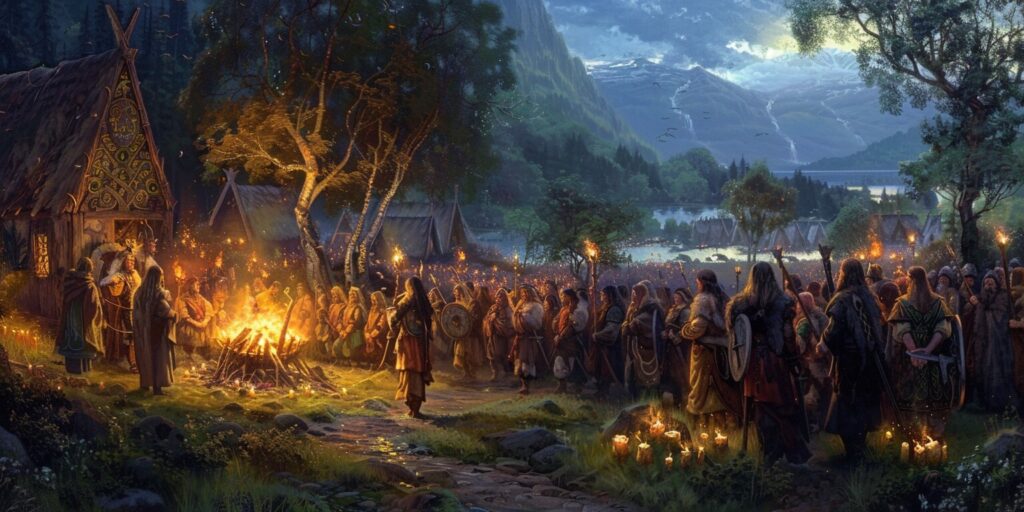
Continuing Traditions
Today, the summer solstice festival continues to be celebrated in Nordic countries and by communities across the world with ties to Viking heritage. It is a time of joy, unity, and a deep connection to nature. Through these celebrations, the traditions and beliefs of the Viking people are kept alive, reminding us of the rich cultural tapestry they wove.
Masks in Viking Seasonal Celebrations
One intriguing aspect of Viking seasonal celebrations was the use of masks, which held great significance in these festive traditions. Masks were not merely decorative but played a crucial role in connecting the Viking community with their spiritual and cultural beliefs.
Types of Masks
The Vikings utilized various types of masks during their seasonal celebrations. One such mask was the Viking warrior mask, which represented bravery, strength, and the warrior spirit. These masks were adorned with intricate designs and often depicted fearsome images, manifesting the warrior ethos deeply ingrained in Viking society.
Another type of mask commonly used in Viking seasonal celebrations was the Viking welding mask. These masks served a practical purpose by shielding the eyes and faces of blacksmiths and metalworkers during their craft. However, they also carried symbolic meaning, representing craftsmanship, protection, and the transformative power of fire.
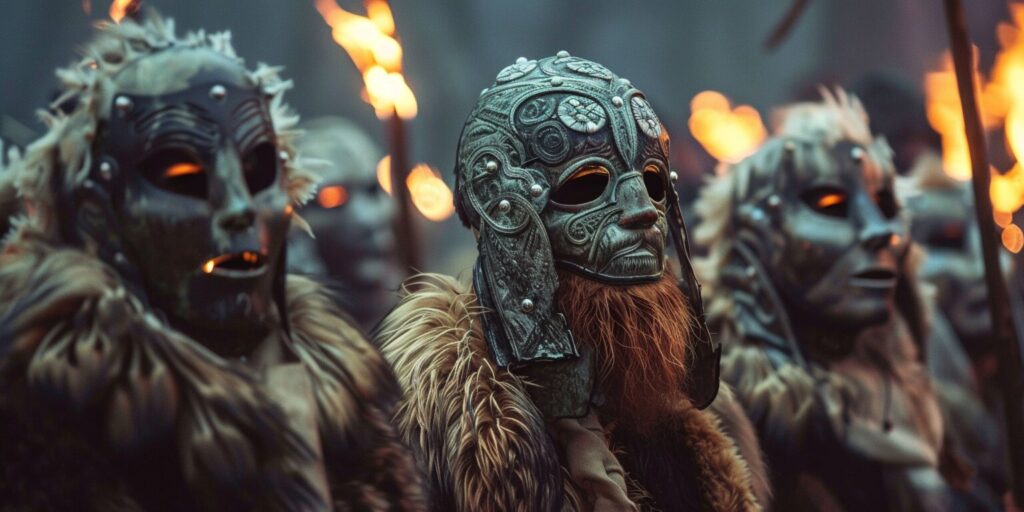
The Symbolism and Purpose
The use of masks in Viking seasonal celebrations went beyond mere adornment; they were imbued with symbolism and served specific purposes. Masks were believed to provide a connection between the human and spiritual realms, allowing individuals to tap into the power and energy of the divine forces.
Warrior masks, for instance, were worn during ceremonies and battles, serving as a form of psychological warfare against their enemies and as a means of invoking courage and invoking the warrior spirit within warriors themselves.
The viking welding masks, on the other hand, represented the transformative power of fire, symbolizing the alchemical process of forging and shaping metal. These masks were worn during rituals and celebrations associated with blacksmithing, signaling the importance of craftsmanship and its vital role in Viking society.
The Legacy of Viking Masks
Today, the legacy of Viking masks can be witnessed in traditional Scandinavian festivities, where individuals don masks to recreate the spirit of Viking seasonal celebrations. These masks serve as a reminder of the rich cultural heritage of the Nordic people and their connection to ancient rituals and traditions.
Viking warrior masks and welding masks continue to inspire modern craftsmanship and artistry, with artists replicating and reinventing these iconic masks. Their symbolism and purpose, rooted in Viking culture, serve as a source of inspiration for contemporary artisans and enthusiasts.
In conclusion, masks held great significance in Viking seasonal celebrations, representing power, spirituality, and craftsmanship. Whether it was the Viking warrior masks symbolizing the warrior ethos or the Viking welding masks embodying the transformative power of fire, these masks played a vital role in connecting the Viking community with their ancestral traditions. Today, they continue to captivate the imagination and evoke a sense of cultural pride in the rich heritage of the Viking people.
Ancient Rituals and Traditions
Viking seasonal celebrations were steeped in ancient rituals and traditions, providing a rich tapestry of cultural heritage for Norse society. These timeless customs were passed down through generations, reflecting the deep-rooted connection between the Viking people and their natural surroundings.
Ancient Rituals
- The Blot: One of the most significant ancient rituals was the Blot, a sacrificial offering to the gods and spirits. It was performed during viking seasonal celebrations to ensure fertility, prosperity, and protection.
- Seidr: Seidr, a form of magic, played a crucial role in the ancient rituals. It involved divination, trance, and contact with the spirit world, allowing the Vikings to gain insights and guidance from the gods.
- Runes: The use of runes, ancient Norse symbols, featured prominently in rituals. These inscriptions were believed to possess magical powers, serving as a means to communicate with the gods and harness their energies.
Nordic Traditions
Viking seasonal celebrations were intertwined with unique Nordic traditions alongside these ancient rituals. These traditions celebrated the changing of seasons, the cycles of nature, and the interconnectedness of life.
- Feasting: Feasting held great significance in Nordic culture, symbolizing abundance, community, and camaraderie. The sharing of food and drink during viking seasonal celebrations fostered a sense of unity and well-being.
- Dances and Music: Vibrant dances and melodic music infused Viking festivals with joy and merriment. These lively performances expressed the Viking people’s creative spirit and celebratory nature.
- Bonfires and Processions: Bonfires illuminated the night skies during Viking celebrations, representing the power of light in the midst of darkness. Processions, adorned with colorful attire and elaborate masks, showcased the vibrant cultural identity of the Norse society.
These ancient rituals and Nordic traditions gave the Viking people a sense of belonging and connection and served as a means to honor their gods and ancestors. They continue to inspire and captivate our imagination, reminding us of the rich cultural heritage behind Viking seasonal celebrations.
Warrior Traditions in Viking Feasts
When thinking of Viking feasts and celebrations, it’s hard not to picture fierce warriors gathered around long tables, toasting and feasting in the midst of their revelries. The connection between warfare and festivities was deeply intertwined in Viking culture, with warriors playing a prominent role in these cultural events.
Viking warriors were not only skilled in battle but were also highly esteemed for their strength and bravery. They were the protectors of their communities, and their presence during feasts added a sense of security and honor. These warriors embodied the qualities that the Viking society admired and revered.
During viking seasonal celebrations, the warrior mask held great significance. These masks, often adorned with fierce and intimidating features, symbolized the warrior spirit and served as a visual representation of the bravery and strength of the Viking warriors. Wearing the warrior mask was a way for these warriors to channel their inner power and invoke the protection of the gods.
Viking Feasts: More Than Just Food
Viking feasts were not just about indulging in food and drink; they were also an opportunity for warriors to display their skills and prowess. Various competitive games and physical challenges were held alongside communal feasting during these celebrations. These physical tests allowed warriors to demonstrate their strength and agility, further solidifying their status and reputation as formidable fighters.
The feasts also provided a platform for warriors to socialize and exchange stories of their heroic exploits. During these gatherings, bonds were forged, alliances were formed, and strategies for future battles were discussed.
The Spirit of Celebration
In Viking culture, feasts and celebrations were not merely events to satisfy hunger or quench thirst. They were deeply rooted in the belief that the gods and ancestors played a vital role in their daily lives. Viking feasts were a way to honor and appease these higher beings, express gratitude for prosperity, and seek protection for the future.
The blend of warfare and celebration showcased the Viking warriors’ commitment to their community and to preserving their way of life. These festivities were a reminder of the strength, bravery, and honor that defined Viking society.
Viking Festivals and Folklore
Immerse yourself in the captivating world of Viking festivals and folklore, where ancient rituals and Nordic traditions come to life. These vibrant celebrations were not just about feasting and merriment; they were steeped in mystical beliefs, captivating myths, and legendary stories that shaped the cultural and spiritual beliefs of the Viking people.
One of the most renowned Viking festivals was the Alþingi, an annual gathering where people from all over the Viking world would converge to discuss law, politics, and trade matters. This assembly was not only a vital political event but also a time for storytelling, sharing folklore tales, and preserving the traditions of their ancestors.
Viking festivals were the perfect opportunity to honor their gods and goddesses, such as Odin, Thor, and Freya. Legends spoke of mighty battles, epic quests, and journeys to other realms. These narratives passed down through generations, were infused with ancient wisdom and provided guidance for the Viking people in their daily lives.
Myths and Legends of the Viking Festivals
- The Legend of the Valkyries: These divine maidens, handpicked by Odin, had the power to choose fallen warriors on the battlefield and accompany them to the afterlife in Valhalla.
- The Mighty Thor and the Giants: Tales of Thor’s heroic battles against fearsome giants, using his mighty hammer Mjölnir, were at the heart of many Viking festival celebrations.
- The Treacherous Sea Serpent: Legends of monstrous sea serpents lurking in the depths of the oceans were a constant reminder of the perils faced by Viking sailors.
- The Golden Apples of Idunn: According to ancient Norse mythology, the goddess Idunn guarded the apples of eternal youth, which were said to grant immortality to the gods.
These myths and legends were entertainment and carried deep symbolism and spiritual significance for the Viking people. They connected to their ancestral roots and reminded them of the virtues and values they held dear.
To this day, the folklore of the Viking festivals continues to captivate and inspire. Whether it’s through reenactments, storytelling, or cultural events, people are drawn to the enchanting tales and ancient rituals that have shaped our collective understanding of the Viking world.
Explore the rich tapestry of Viking festivals and folklore and uncover the secrets that have been passed down through centuries. Embark on a journey into the past and discover the fascinating blend of ancient rituals, mysterious legends, and enduring Nordic traditions that continue to thrive in our modern world.
Modern Interpretations of Viking Seasonal Celebrations
While Viking seasonal celebrations may be rooted in ancient traditions and pagan holidays, they continue to thrive in the modern world, serving as a vibrant testament to Nordic traditions and cultural heritage. Today, a variety of events and festivals embrace the spirit of the Vikings, offering visitors a unique opportunity to immerse themselves in the customs and rituals of the past.
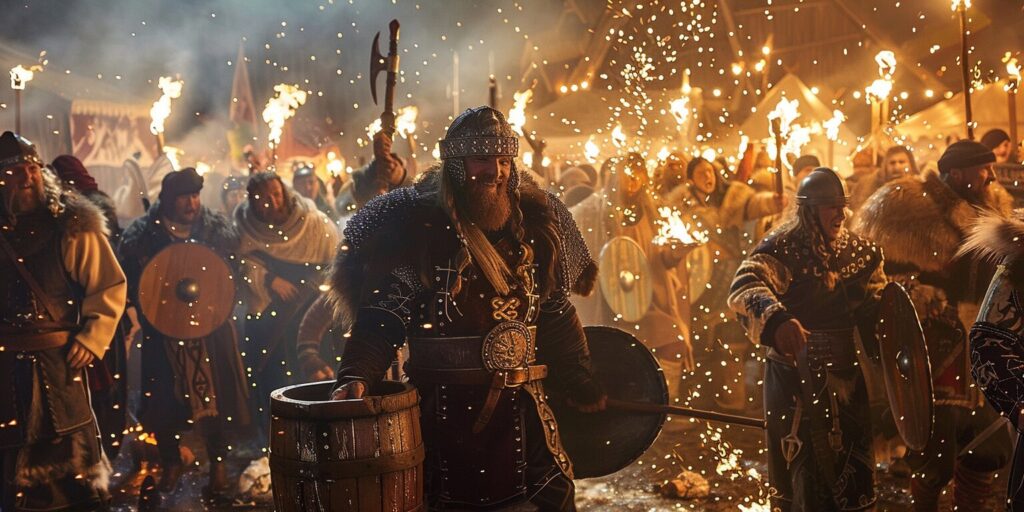
One such event is the annual “Nordic Winter Festival” held in Oslo, Norway. This festive gathering showcases traditional Viking feasts, live music performances, and reenactments of ancient rituals. Visitors can witness the lighting of the Yule log, the centerpiece of the winter solstice celebration, and partake in communal feasting, an essential aspect of Viking seasonal festivities.
Another remarkable modern interpretation of Viking seasonal celebrations is the “Midsummer Festival” held on the Swedish island of Gotland. This vibrant event brings together locals and tourists alike to commemorate the summer solstice in true Viking style. Participants can join in traditional dances around the maypole, witness mock battles reminiscent of Viking warriors, and savor authentic Nordic cuisine.
For those seeking a deeper immersion into Norse culture, the “Jorvik Viking Centre” in York, England, offers an unparalleled experience. This interactive museum takes visitors back in time, recreating Viking-age streets and showcasing artifacts from this captivating era. The center also hosts special events and workshops throughout the year, providing a hands-on exploration of Viking traditions and practices.
Modern Reinterpretations of Viking Seasonal Celebrations in Popular Culture
Viking seasonal celebrations have inspired traditional events and found their way into modern pop culture. Film and television productions, such as the popular series “Vikings,” have captured the imagination of audiences worldwide, shedding light on the rich tapestry of Viking traditions and pagan holidays.
Additionally, Viking-inspired music has gained a dedicated following, with bands like “Wardruna” and “Skálmöld” infusing ancient Norse melodies into their compositions. Their performances often evoke the majesty and mysticism of Viking seasonal celebrations, transporting listeners to a world of warriors, gods, and mythical creatures.
Ultimately, the modern interpretations of Viking seasonal celebrations serve as a testament to the enduring influence of Nordic traditions and pagan holidays. By embracing these ancient customs, both in traditional events and contemporary creative expressions, we honor the legacy of the Vikings and keep their vibrant cultural heritage alive.
Unearthing the Truth: Viking Seasonal Celebrations Revealed
After delving into the origins, traditions, and rituals of Viking seasonal celebrations, it becomes clear that these ancient traditions hold great significance in Norse culture. From pagan holidays to ancient rituals, Viking seasonal celebrations offer a captivating glimpse into the cultural heritage of the Viking people.
Throughout this article, we’ve explored the various feasts and festivals that took place during these special times of the year. From the winter solstice celebration of Yule to the summer solstice festival of Midsummer, these events were a time of merrymaking, communal feasting, and an opportunity to honor the changing seasons and connect with the spiritual realm.
The Role of Ancient Rituals and Traditions
Ancient rituals and traditions formed the backbone of Viking seasonal celebrations. Passed down through generations, these customs held deep meaning and played a vital role in Norse society. Whether it was wearing intricate masks, performing sacred ceremonies, or reciting mythological tales, every aspect of these celebrations was carefully crafted to honor the gods, commune with nature, and ensure a bountiful harvest.
The connection between Viking seasonal celebrations and pagan holidays cannot be overlooked. These festivals were rooted in the worship of Norse deities, with offerings and sacrifices made to appease and seek favor from the gods. As the seasons changed, the Vikings saw it as a time for both celebration and renewal, reflecting their close bond with the natural world.
The Importance of Understanding and Preserving Tradition
Understanding the truth behind Viking seasonal celebrations is not solely an exercise in historical curiosity but an opportunity to preserve and honor these ancient traditions. By unearthing the Viking people’s customs, beliefs, and rituals, we gain a deeper appreciation for their rich cultural heritage and the profound significance these celebrations held in their lives.
Preserving these ancient traditions ensures that they are passed down to future generations, keeping the Viking spirit alive. As our modern world becomes increasingly connected and fast-paced, taking the time to reconnect with nature, honor our ancestors, and celebrate the changing seasons can provide a sense of grounding and connection that is essential for a well-balanced life.
Conclusion
Throughout this article, we have explored the fascinating world of Viking seasonal celebrations and the significance of masks in these festivals. From the origins rooted in ancient rituals and pagan holidays to the specific feasts and celebrations that took place, Viking culture is rich with traditions that honor the changing seasons.
The winter solstice brought the festive celebration of Yule, while the lively Midsummer festival marked the summer solstice. Masks played a vital role in these celebrations, from warrior masks symbolizing strength and protection to welding masks depicting the craftsmanship of the Viking people.
By unearthing the truth behind Viking seasonal celebrations, we gain a deeper appreciation for the cultural heritage of the Viking people. These traditions continue to be interpreted and celebrated in modern times, bridging the gap between ancient Norse society and the present day. Let us not forget the wisdom and significance of these rituals, preserving them for future generations to cherish and learn from.

